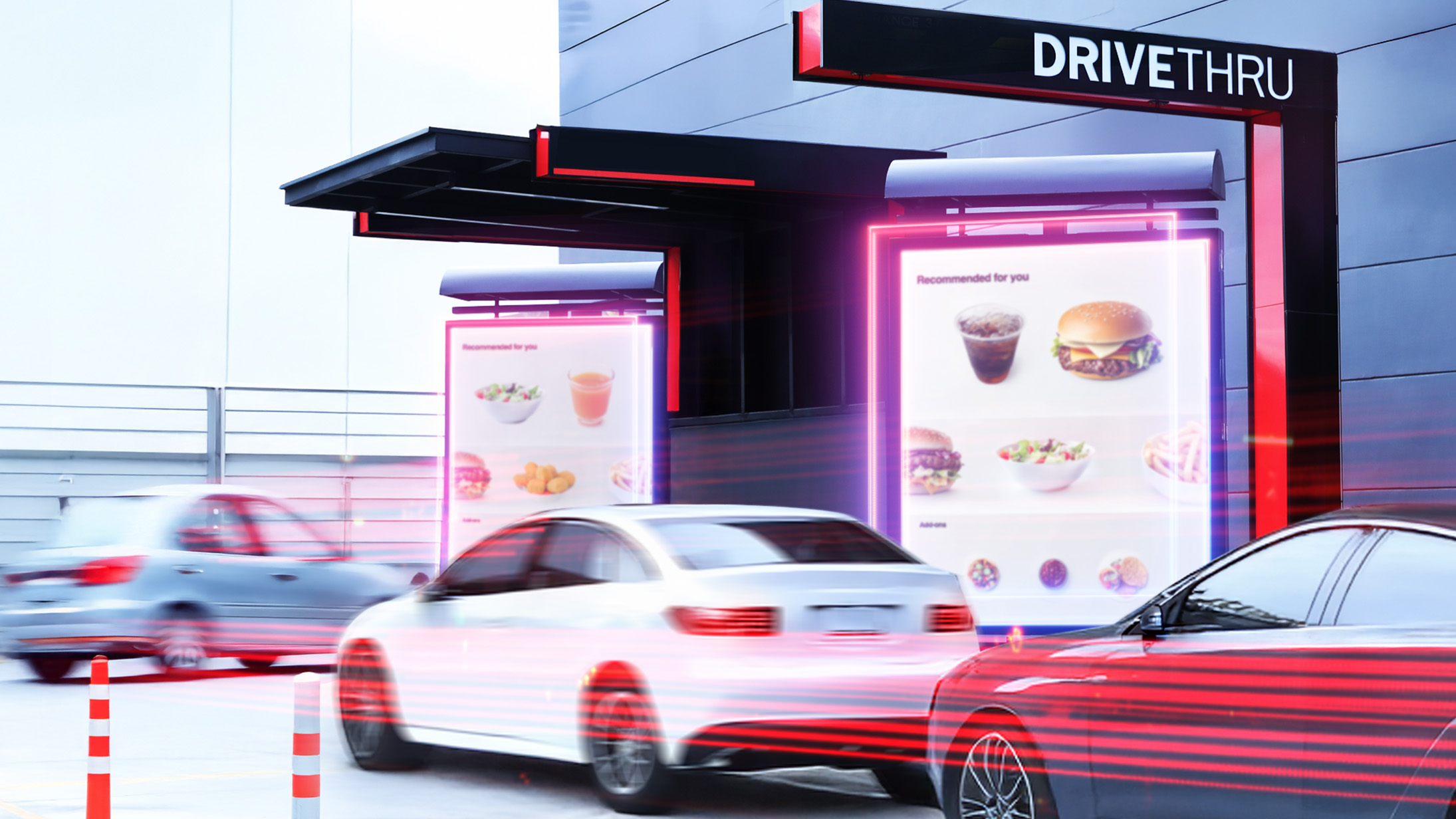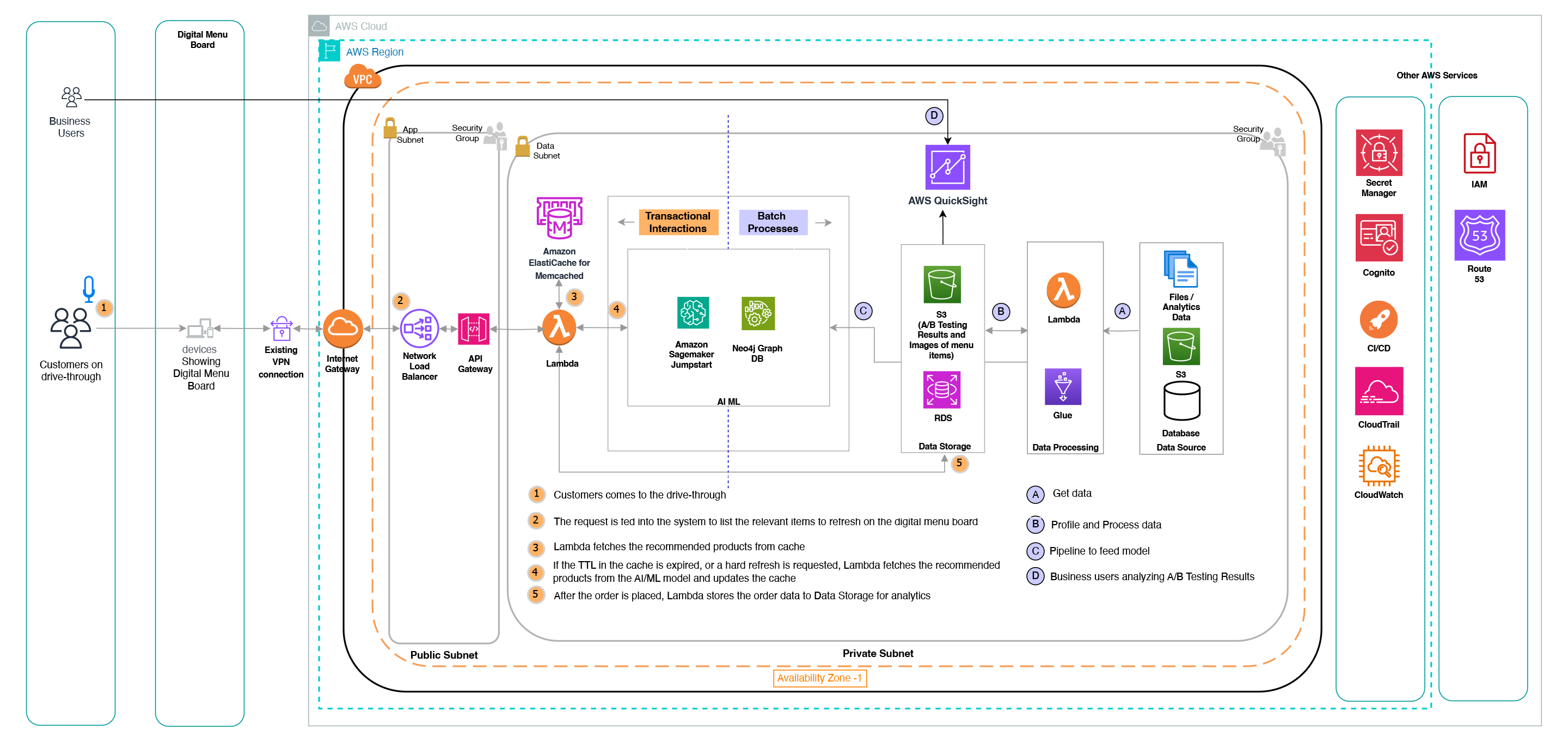What issue can we solve for you?
Type in your prompt above or try one of these suggestions
Suggested Prompt


From Static to Dynamic: How AI and AWS Are Optimizing Drive-Thru Menus for Growth


In today’s competitive landscape, Quick Service Restaurants (QSRs) are transforming their drive-thru channels to deliver more personalized and engaging customer experiences. Challenges in the drive-thru experience include a small known customer base, manual insight generation, a lack of a data-driven merchandising strategy, and system silos. Leveraging data and AI-driven solutions in the drive-thru experience is crucial for driving growth in QSRs.
AI-driven solutions require building a scalable decision engine that leverages AI/ML for asynchronous optimization and the strategic placement of menu items on digital menu boards (DMBs) in drive-thru lanes, enhancing the interactive customer experience. This approach has been shown to produce statistically significant results, demonstrating that customers are more likely to purchase when menu items are personalized. Creating a next-generation drive-thru experience that is dynamic, culturally relevant, and effective in driving sales for both known and unknown customers significantly increases agility and maximizes business growth.
This post highlights how AWS services enable a unified, scalable approach to data ingestion, processing, and the implementation of AI-driven recommendation engines to present the right products to customers. By enhancing customer engagement, increasing order value, and improving loyalty, these solutions create seamless customer experiences. It also demonstrates how AWS empowers these capabilities, transforming the drive-thru experience and ultimately driving growth and customer satisfaction.

Market Trends
An efficient and optimized drive-thru experience is essential for meeting customer expectations, improving order accuracy, and maximizing revenue.
For QSRs, this involves leveraging AI to create dynamic, personalized menu boards that adapt to customer data and trends in real time.
Many QSR brands are shifting from legacy, siloed systems to integrated, cloud-based platforms that enhance data sharing, scalability, and operational efficiency.
With the rise of A/B testing and data-driven decision-making, QSRs can continuously optimize and measure the impact of digital initiatives. A/B testing has become a critical tool, enabling them to experiment with menu configurations and refine AI models based on key metrics. This drives a more responsive and iterative approach to customer engagement.
Solution
The solution focused on developing a scalable, AI-driven recommendation engine to optimize digital menu boards (DMBs) in the client’s drive-thru lanes. By leveraging AWS's scalable infrastructure and advanced services - including Lambda, Glue, API Gateway, S3, RDS, and AI/ML services like SageMaker - along with advanced algorithms for graph-based data analysis and Cypher queries for generating product recommendations, I designed a robust data pipeline to feed data into the decision engine. To ensure security, I integrated AWS services such as Cognito, Network Load Balancer, VPC Endpoints, IAM, and Secrets Manager. The personalized menu item recommendations were driven by key factors, including location, time of day, customer purchase patterns, and high-margin products.
The solution incorporated A/B testing capabilities to evaluate the performance of personalized versus standard menu configurations, along with analytics to measure their impact on average order value. This provided valuable insights for refining the recommendation model based on real-time performance data. Additional metrics, such as top-selling products of the day/week, frequently purchased product combinations, high-margin items, and new or limited-time offerings (LTOs), were also leveraged to enhance recommendations.
This end-to-end solution showcases how AWS enables scalable, secure, and data-driven architectures, empowering QSRs to enhance customer satisfaction and drive growth through personalized digital experiences.
The Power of Partnering with AWS
Our collaboration with AWS enabled the development of a scalable, data-driven recommendation engine tailored for the QSR industry. This partnership leveraged AWS’s robust infrastructure and advanced AI/ML services, delivering several key benefits:
- Scalability and High Availability: The architecture is designed for scalability and resilience, utilizing AWS services like Lambda for automatic scaling and multi-AZ/multi-region deployments to ensure high availability. By leveraging managed services, the recommendation engine can seamlessly scale to handle large data volumes from multiple drive-thru locations, supporting peak traffic without compromising performance.
- Advanced Data Processing and Machine Learning Capabilities: Leveraging AWS services like S3, Lambda, Glue, and SageMaker, I built a sophisticated data pipeline and integrated advanced machine learning algorithms. Using graph-based data analysis, the system dynamically personalized menu recommendations based on historical transactional data.
- Enhanced Security and Compliance: AWS security services - including Cognito, Network Load Balancer, VPC Endpoints, and API Gateway with API key authentication - helped secure the client’s data and ensure regulatory compliance. These measures were critical in protecting sensitive transaction and consumer information.
- Accelerated Deployment and Innovation: Leveraging AWS's CI/CD tools and managed services streamlined the deployment process, enabling the client to rapidly test, iterate, and roll out new features that improved customer experience and drove revenue growth.
This collaboration showcases how AWS empowers our solutions to deliver high-impact business results, transforming drive-thru operations for a modern, data-driven, customer-centric QSR experience.
Solution Architecture and Design
The solution is designed to be implemented in two phases:
The first phase leverages SageMaker Jumpstart and Neo4j to power the recommendation engine, generating product recommendations using Cypher Queries and advanced graph-based data analysis algorithms. This solution enables different menu versions to be displayed within the same store at various times, or across multiple stores at the same time, creating highly personalized menu boards for each location.

FIGURE 01
AI/ML-Driven Recommendation Engine Architecture using AWS Services.
The second phase of the architecture outlines how the end-to-end solution has been designed using additional AWS services, including Amazon Personalize for generating real-time, personalized menu recommendations based on customer interactions, purchase history, and preferences. SageMaker AI is used for fine-tuning, and customizing foundation models, with Amazon SageMaker Data Wrangler transforming data to prepare it for machine learning (ML). Additionally, Bedrock Claude 3 powers voice AI to process customer queries (e.g., ‘Show me vegetarian options’) while Bedrock Titan Text Embeddings converts text - such as menu items, customer interactions, and order history - into vectors vector representations (embeddings).

FIGURE 02
Real-Time AI/ML-Driven Recommendation Engine with Personalized Menu Suggestions and Voice Interaction using AWS Services.
The following outlines the end-to-end data pipeline of the solutions built using AWS services:
- Batch process that involves creating data pipelines to read, profile, and prepare data for the models, enabling them to generate products recommendations.
- Transactional Interactions, where a different menu is shown to each customer in the drive-thru, including a default national menu version. This also integrates voice AI, allowing customers to request specific food categories (e.g., asking to see vegetarian options).
- PRIVATE APIs are created to deliver recommended products from the model to the consumer refreshing the digital menu board, and to capture the order transaction for each drive-thru customer.
- APIs Security is ensured through IP whitelisting on the network load balancer, which routes API requests to the VPC end point of the API Gateway. Cognito user pools handle authorization and authentication. APIs are exposed via domain names (on https) using Route 53, with certificates managed via ACM. Secrets Manager secures database credentials, and API keys are used for additional security of the APIs.
- CloudWatch and CloudTrail are used for monitoring and logging API requests.
- EastiCache for Memcached is used to support the scale of refreshing the menu board for each drive-thru customer, preventing backend calls for every time
- Amazon Quicksite is used to create interactive dashboards, visualizations, and reports.
Conclusion
Creating a first demonstration of how AI can transform the drive-thru experience, strengthen data capabilities for generating new insights, and build organizational excitement.
- Create a next generation drive thru experience that is dynamic, culturally relevant, and effective in driving check for both known and unknown customers
- Radically increase agility and maximize business impact by moving from longitudinal market testing to A/B testing
- Clearly articulate the experience vision to drive excitement and foster adoption within the franchisee community
- Leveraging AI on the DMB to display the right products to customers, leading to higher sales and enhanced customer loyalty.
Engage with Experts and Leverage Their Expertise

- Explore AWS Solutions for Personalization: Visit AWS’s resources on AI/ML, and recommendation engine solutions to learn more about how these technologies can enhance customer experiences in the QSR and retail industries.
- Connect with Our Team for a Consultation: Contact the Publicis Sapient team for a personalized consultation to explore how AI-driven recommendations can optimize their business and drive growth through data-driven insights.
- Start Building with AWS: Take advantage of AWS’s free-tier services to experiment with building a custom recommendation engine and explore use cases relevant to their business.

Publicis Sapient – AWS Partner Spotlight
Publicis Sapient is an Advanced AWS Global Digital Business Transformation Partner and AWS Competency Partner that designs and builds AWS based Customer Data & AI, eCommerce, Digital Marketing, Salesforce and Mobile platforms through their 3000+ AWS Certified architects & engineers. DevOps & cloud experts at Publicis Sapient design, migrate & manage cloud workloads 24X7, efficiently.



